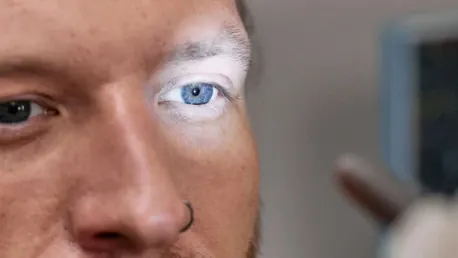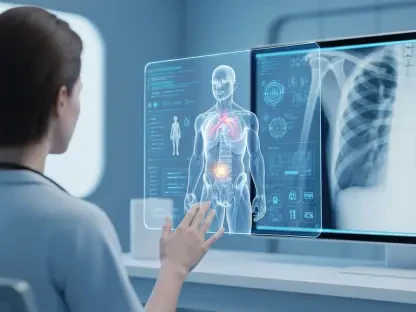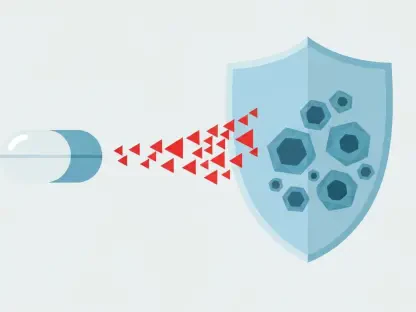A groundbreaking study published in The Lancet has revealed promising results for the use of stem-cell-derived corneal implants in restoring vision for patients suffering from limbal stem cell deficiency (LSCD). This condition, which leads to significant vision impairment due to the loss of corneal stem cells, has traditionally been challenging to treat. The new study explores the safety and preliminary efficacy of human induced pluripotent stem cell (iPSC)-derived corneal epithelial cell sheets (iCEPS) as a novel therapeutic option in combating this debilitating condition.
LSCD is characterized by the loss of limbal stem cells, essential for regenerating the corneal epithelium. These cells, located at the cornea’s edge, play a crucial role in maintaining clear vision. The degeneration of these cells, due to trauma, immune conditions, or genetic factors, leads to profound corneal damage, conjunctival scarring, and severe vision problems. Traditional treatments involve autologous or allogeneic grafts. However, these methods often face challenges including immune rejection, quality inconsistencies, and the necessity for biopsies. Against this backdrop, the emergence of iPSC-derived corneal grafts presents a promising and feasible alternative that warrants further validation.
Understanding Limbal Stem Cell Deficiency
LSCD is a condition marked by significant vision impairment due to the loss of crucial limbal stem cells, which are vital for the regeneration of the corneal epithelium. These limbal stem cells are strategically located around the edge of the cornea and are indispensable for maintaining clear vision. When these cells are lost as a result of trauma, immune conditions, or genetic factors, it triggers corneal damage, conjunctival scarring, and severe vision problems. Traditional treatments have primarily involved autologous and allogeneic grafts.
However, these traditional methods face numerous challenges. Immune rejection is one of the significant hurdles, where the patient’s immune system recognizes the graft as foreign and attacks it. This can lead to graft failure and necessitate further medical interventions. Additionally, there are quality inconsistencies in graft materials, which can affect the overall outcome of the treatment. The process of obtaining these grafts often requires biopsies, which is another invasive procedure that carries its own risks and complications. Therefore, the need for alternative and innovative treatments is paramount in addressing the complexities of LSCD.
The Promise of iPSC-Derived Corneal Grafts
iPSC-derived corneal grafts offer a promising alternative to traditional LSCD treatments. The study conducted at Osaka University Hospital involved four adult participants with varying stages of LSCD, ranging from moderate (IIB) to severe (III). Participants were observed over 104 weeks, comprising a 52-week active study period followed by an additional 52-week safety period. This single-arm, open-label study was diligently approved by Japan’s health and ethics committees, ensuring strict adherence to ethical standards. Importantly, participants provided informed consent through materials accessible to visually impaired individuals, emphasizing the study’s commitment to inclusivity and patient care.
The clinical procedures were meticulously designed and included several critical steps: the creation and purification of corneal stem cells from iPSCs, the manufacturing of iCEPS, and a keratectomy to remove fibrotic tissue from the patients’ eyes. Postoperative care encompassed the administration of antibiotics, corticosteroids, and therapeutic contact lenses to facilitate optimal healing and minimize infection risks. The primary endpoint of the study focused on safety, evaluating adverse events meticulously. Secondary endpoints included various efficacy metrics such as visual acuity, LSCD stage, and corneal health assessed at multiple intervals, providing a comprehensive understanding of the grafts’ impact.
Clinical Procedures and Postoperative Care
Creating and purifying corneal stem cells from iPSCs involved rigorous processes to ensure the highest quality and safety standards. The manufacturing of iCEPS was carefully managed to produce a viable graft ready for transplantation. A crucial element of the procedure was performing a keratectomy to remove the fibrotic tissue from the patients’ eyes, laying the groundwork for successful graft integration. Postoperative care protocols were diligently followed, including the use of antibiotics to prevent infections and corticosteroids to manage inflammation. Patients were also fitted with therapeutic contact lenses to enhance recovery.
The primary endpoint of the study was safety, with researchers closely monitoring adverse events throughout the study’s duration. Secondary endpoints provided further insights into the efficacy of the treatment. Metrics such as visual acuity, LSCD stage, and overall corneal health were evaluated at various intervals, offering a detailed assessment of the participants’ progress. These metrics were critical in understanding not only the immediate impact of the grafts but also their long-term viability and effectiveness in restoring vision.
Safety and Efficacy of iCEPS
The iCEPS utilized in the study demonstrated a unique cobblestone-like appearance, consisting of a multilayer structure featuring essential corneal epithelial markers. Rigorous quality control and tumorigenicity assessments, including tests on immunodeficient mice and comprehensive karyotype analyses, confirmed the absence of tumorigenic potential. Ensuring the cells’ safety was of utmost importance. The cells underwent cryopreservation and meticulous preparation in compliance with good manufacturing practice standards, underscoring the procedural rigor and adherence to safety protocols.
Results from the study were highly encouraging, as no immunological rejection or tumor formation was observed in any of the participants. The absence of adverse immunological responses suggested that HLA compatibility and additional immunosuppression might not be necessary, simplifying the treatment protocol. Patients with varying LSCD etiologies, such as idiopathic LSCD and ocular mucous membrane pemphigoid, successfully received HLA-mismatched transplants without signs of rejection. These findings highlight the potential of iCEPS as a viable and less complicated alternative to traditional grafts, providing a solid foundation for future clinical applications.
Clinical Improvements and Patient Outcomes
Throughout the study’s duration, researchers recorded 26 minor adverse events, all of which were mild and manageable, demonstrating the treatment’s safety profile. No serious adverse events were noted, and nine non-serious events occurred during the additional one-year safety monitoring period. Clinically, significant improvements were observed, with LSCD severity decreasing for all patients. Notably, patients 1 and 2 improved from stage III to IA, patient 3 from stage IIB to IA, while patient 4 initially improved from stage III to IA but regressed to IIB after one year.
Corneal epithelial defects either stabilized or improved, with most patients achieving grade 0 (indicating no defect) by the 52-week mark, except for the fourth patient who remained at grade 1. The results underscore the potential impact of iCEPS transplantation in stabilizing or enhancing corneal health. These clinical improvements are particularly noteworthy given the challenges associated with traditional treatments, showcasing the transformative potential of stem-cell-derived solutions in managing LSCD.
Visual Acuity and Quality of Life
The study also highlighted notable improvements in visual acuity and quality of life for participants. The corrected distance visual acuity improved significantly, particularly for the first two patients. Participants experienced reduced corneal opacification, leading to clearer vision and contributing to an overall improvement in their symptoms. These physical improvements were complemented by enhanced quality of life scores for patients 1, 2, and 3, reflecting the broader impact of the treatment on daily living. However, it is important to note that patient 4 experienced a decline, underscoring the variability in individual responses to the treatment.
Additionally, corneal neovascularization decreased in patients 1 and 2 but remained stable or increased for patients 3 and 4. The stability of symblepharon severity by week 52 further emphasizes the treatment’s efficacy. Despite some regression observed in patient 4, which could be due to subclinical immune responses, the overall outcomes demonstrate the potential benefits of iCEPS transplantation. The study’s findings reinforce the necessity for ongoing research to better understand individual response variability and refine the treatment protocol for broader applications.
Future Directions for iCEPS Transplantation
A groundbreaking study published in The Lancet has demonstrated promising results for using stem-cell-derived corneal implants to restore vision in patients suffering from limbal stem cell deficiency (LSCD). Characterized by the loss of essential corneal stem cells located at the cornea’s edge, LSCD leads to significant vision impairment. The loss of these cells, due to trauma, immune conditions, or genetic factors, results in profound corneal damage, conjunctival scarring, and severe vision problems.
Traditional treatments for LSCD involve using autologous or allogeneic grafts, which often face challenges such as immune rejection, quality inconsistencies, and the necessity for biopsies. The new study investigates the safety and preliminary efficacy of human induced pluripotent stem cell (iPSC)-derived corneal epithelial cell sheets (iCEPS) as a novel therapeutic option. This innovative approach offers a promising and viable alternative to traditional methods, which have long posed significant difficulties. The emergence of iPSC-derived corneal grafts represents a significant advancement in treating LSCD, warranting further validation.









